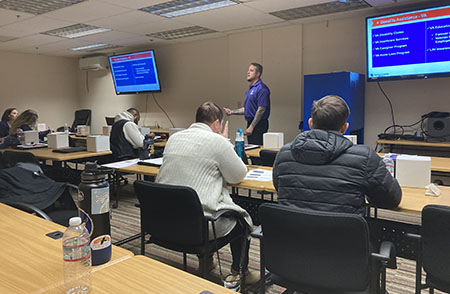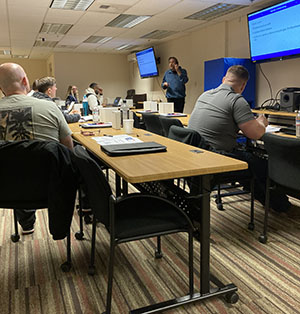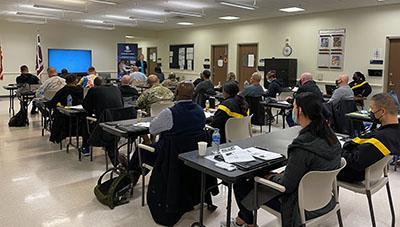WWP’s Transition Ready Program Expands Reach to Help Service Members Prepare for Civilian Life

Wounded Warrior Project® (WWP) aims to prepare warriors for the next stage of their lives after service and helps them to navigate the transition back into the civilian world. WWP’s Transition Ready program reaches active-duty service members before they exit the service, to inform them of benefits, resources, and other opportunities.
“It’s a great way to reach them earlier,” said Tony Hinojosa, Warriors to Work career transition manager. “And it’s not necessarily just telling them about what we do when it comes to employment or benefits. With the transition ready [program], we're talking about all of our programs and all the resources they have out there.”
By tapping into the Transition Ready program, exiting service members are educated on how to file for benefits, find new employment, get financial education, and find out what resources are available to them.
The WWP Transition Ready team usually visits warriors at their military installations, to answer their questions and provide information. The program is seeing impressive growth, expanding to other military bases across the country, including recent visits to Air Force bases in Fairbanks and Anchorage, Alaska. The Transition Ready team is also making efforts to reach student veterans as they prepare to enter the job market.
Regardless of whether they’re retiring from service, being medically discharged or it’s the end of their time in service, the unknown looms large when leaving the military. WWP can help ease those concerns.
Joining the Civilian Workforce
For warrior Matthew Fox, who attended WWP’s Transition Ready program at Fort Campbell, Kentucky, learning tips for maneuvering the employment process in the civilian sector, was a huge help. WWP’s 2022 Annual Warrior Survey found the WWP warrior unemployment rate to be higher than other veteran populations and the general U.S. population, and most similar to the rate among the U.S. general population with a disability.

“One of the things that really struck me was being told that you have transferable skills,” Matthew said. “I think that every veteran has something to contribute to an organization. It may not be a hard skill or specific skill set, but what [veterans] do have is a willingness to learn, adaptability, and leadership experience that nothing else in the world can really give them.”
He said the job preparation help he got through the WWP Transition Ready program was instrumental in preparing him for job hunting outside of the military.
“I think the Wounded Warrior Project’s Transition Ready program was definitely a huge help,” Matthew said. “For me, I attended the interview prep session, and that was a huge help, especially the mock interviews. That helped me see where I was at with my interviewing skills, as well as where I needed to improve. I think that was probably the best event that I attended.”
Because of what he learned in the Transition Readiness program, Matthew already had a job lined up before he got out of the Army. He was able to find a tech job at a financial company through its “military pathways” program and was able to connect to other veterans in the business.
“One of my concerns is definitely the camaraderie and culture [of a civilian job],” Matthew said. I was more concerned about finding an organization that had the right culture that would really include me and various veterans from across the services into its culture.”
With the major concern of finding work and earning income already addressed before he left the service, Matthew said he felt better prepared to make the move to his civilian life.
“I think if a company is not necessarily taking advantage of a veteran [workforce], they're really losing out on awesome talent and people who are motivated and driven to work.”
Finding Their Financial Footing
Financial concerns are a big issue for most people who are making a career change, but it’s probably even more relevant for service members preparing to leave the military. After leaving the service, warriors will often face the struggle of having their income reduced. They may have to wait weeks or months for VA disability or retirement pensions to kick in, and they are no longer receiving service pay and basic allowance for housing (BAH).

Tony said oftentimes veterans aren’t reaching out until they’re in desperation mode.
“All of our programs are available to [warriors] before or while they’re transitioning out of the military,” he said. “They don’t have to wait to come to us or benefit from our programs five years down the road, when they’re behind on their mortgage, or need to find a job, or struggling with their benefits claims. Let’s give them the tools earlier.”
That’s why it’s important to start the process early, so warriors can minimize any financial struggles they may face when they get out and don’t miss out on any benefits they’re entitled to. The longer injured veterans wait to file their claims, the longer they miss out on benefits they’ve earned from their service.
Reaching out for Resources
One of the main things service members need to keep in mind during the transition process is that it’s OK to ask for help.
For Matthew, the willingness to reach out helped him get a jump start on his future outside the service and minimize the stress of his transition to civilian life.
“People are more willing to help you than you realize,” Matthew said. “It's a new world that we haven't necessarily been in for a while, so just be willing to learn.”
Increased exposure to WWP’s Transition Ready program can help veterans better prepare for their future and plan accordingly.
“Probably six months before transitioning out is an ideal time to start working with us, and just getting the resume and doing some interview prep and networking,” Tony said. “Then about three months out is when they should really start interviewing.”
Another component of the Transition Ready program is that a service member’s family can take advantage of it, too.
“We also invite family support members and their dependents to come to the transition-ready events as well because we know they’re the ones who are likely to have the most influence on the service member,” Tony said. “Plus, they’re eligible for services, too.”
Any service member or family member can attend a Transition Ready session on their base, and they may be surprised about the numerous resources that could be available to them.
“We also try to clear up any misconceptions because a lot of service members think they have to have some catastrophic injury or had to have been in combat, but that isn’t the case.”
A Holistic Approach
Tony said some of the adjustments some service members may not consider when it comes to returning to civilian life include moving to areas with little military populations, resulting in a loss of camaraderie, and having to be responsible for health care, maybe for the first time. WWP’s Transition Ready program aims to create an individualized effort to reach warriors and address their individual circumstances and concerns.
“I think what differentiates us is that our programs are individualized because each one is looking for something different and each one is different,” Tony said.
And while the Transition Ready program primarily focuses on the immediate needs of a warrior after military service, it also works closely with WWP’s wide range of other programs and services to ensure the warrior’s physical and mental needs are being met well after they have transitioned as well.
“The way I look at Wounded Warrior Project is that it’s a holistic approach [to veteran care],” Tony said. “Every program feeds into one another and I think if we're catching them earlier, we’re setting them up for success sooner.”
Contact: — Paris Moulden, Public Relations, pmoulden@woundedwarriorproject.org, 904.570.7910
About Wounded Warrior Project
Since 2003, Wounded Warrior Project® (WWP) has been meeting the growing needs of warriors, their families, and caregivers — helping them achieve their highest ambition. Learn more.